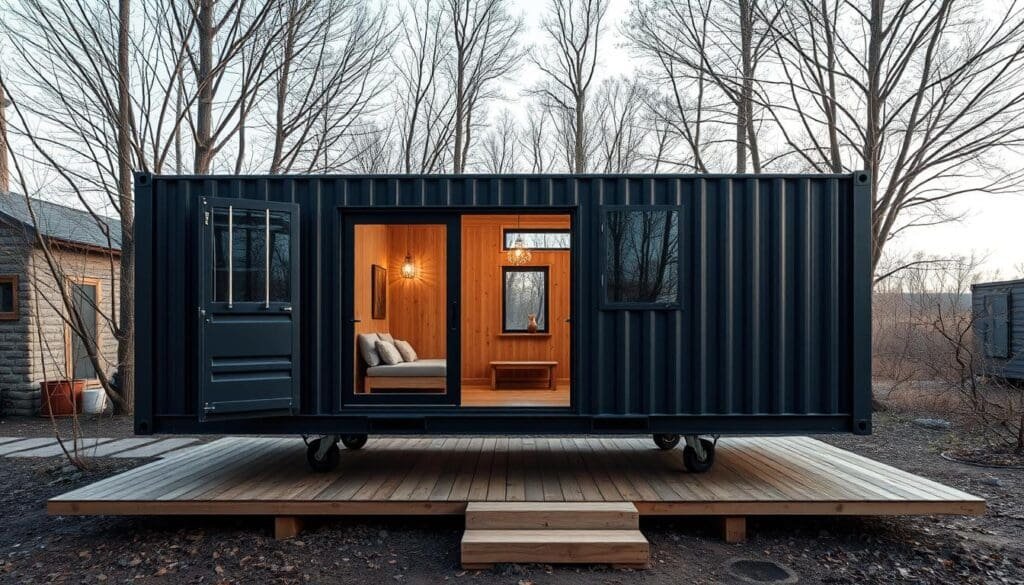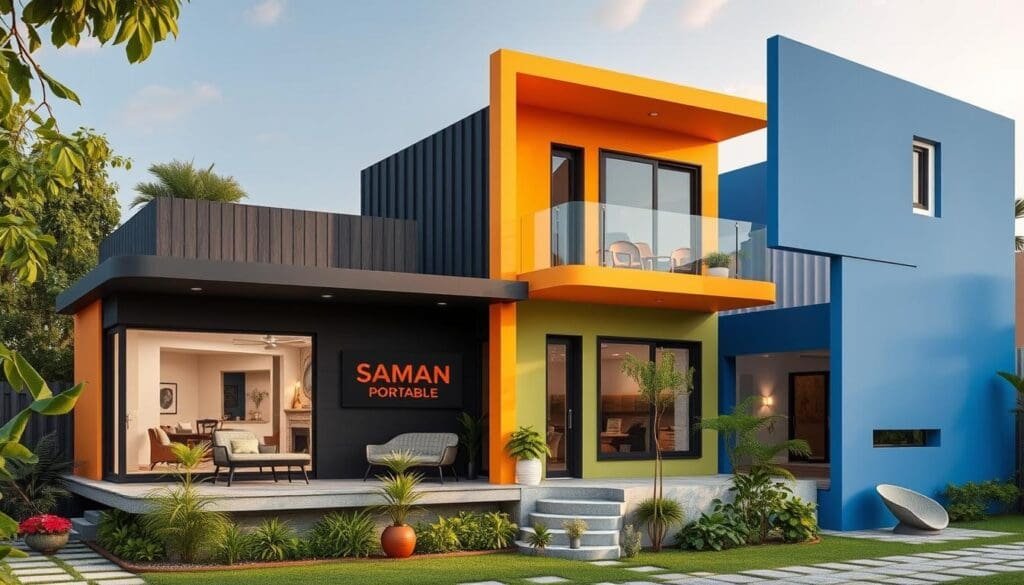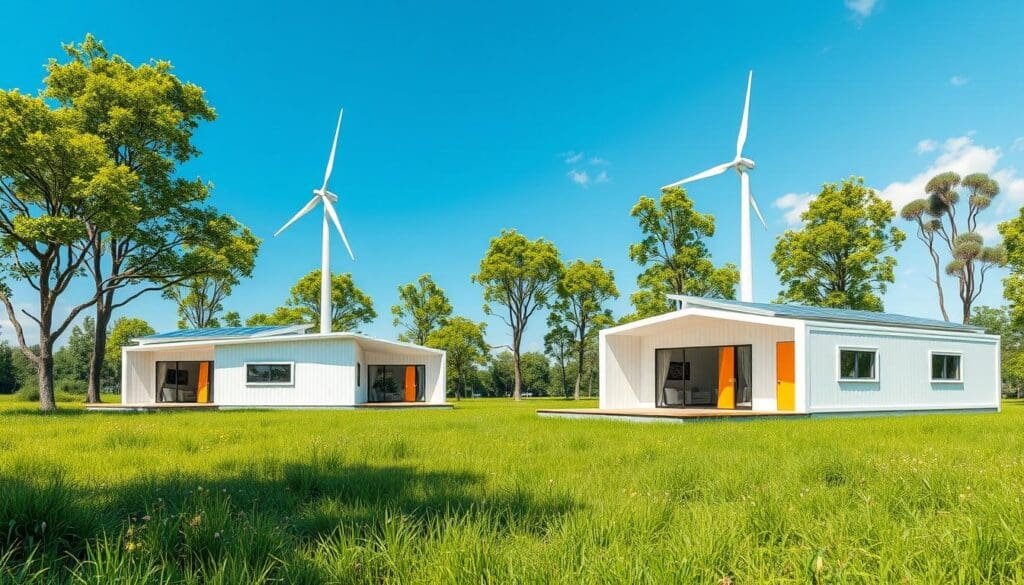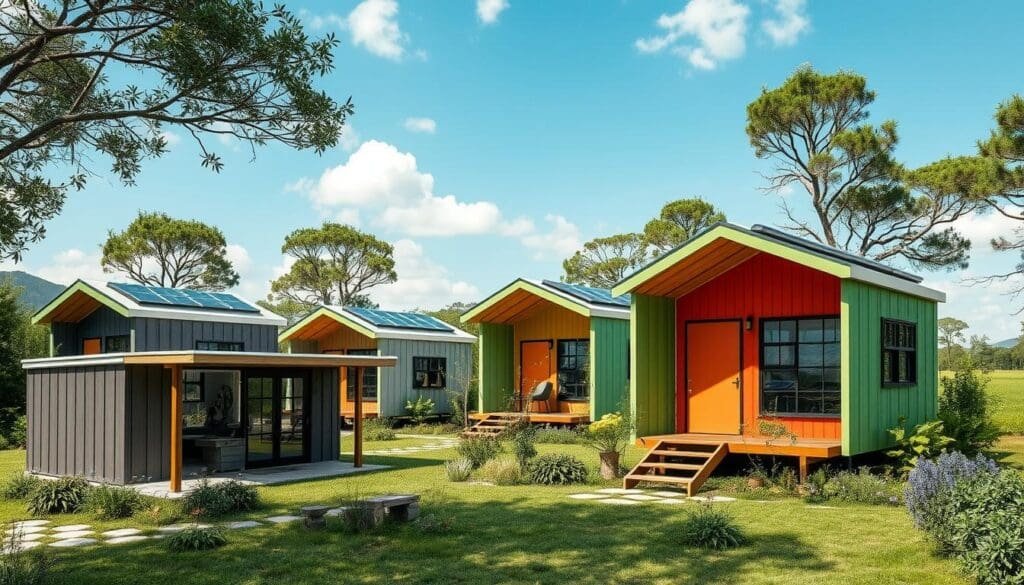Lightweight Structures: Redefining Sustainability with Container Houses
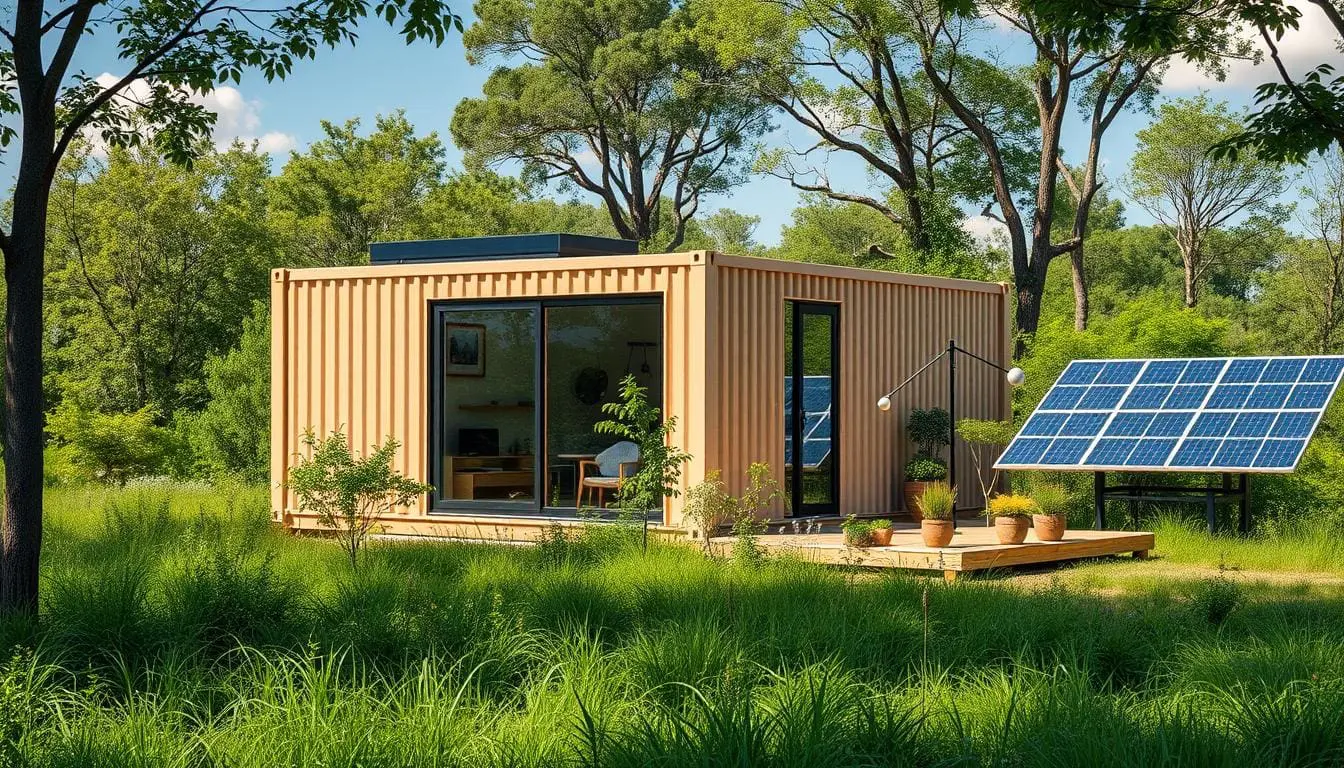
Did you know a single 40-foot shipping container can offer 320 square feet of living space? This fact shows how container houses are changing the game in sustainable housing. They’re a new way to build homes.
Container houses use old shipping containers. They’re all about simple living, being affordable, and easy to move. These small homes make people think differently about what they need, encouraging a simpler way of life.
These homes also come with green features like solar panels and rainwater systems. This makes them even better for the planet. The rise of container house communities brings people together. They share ideas on living sustainably and creatively.
Key Takeaways
- Container houses offer a sustainable and affordable housing solution, utilizing repurposed shipping containers as the primary building material.
- These compact structures, typically around 320 square feet, prioritize functionality and simplicity, promoting intentional living.
- Container houses integrate eco-friendly features like solar panels, rainwater harvesting, and green roofs, enhancing their sustainability.
- The growing container house movement fosters a sense of community and collaboration among individuals committed to innovative and sustainable architecture.
- Shipping containers are designed to withstand harsh conditions, making them durable and weatherproof for residential construction.
Understanding Container Houses: A Modern Housing Revolution
Container architecture has changed the housing world. What were once simple shipping containers now serve as homes. They are durable, affordable, and good for the environment. This new way of building homes is changing how we think about living spaces.
Evolution of Shipping Container Architecture
Using shipping containers for homes is not new, but it’s getting more popular. These strong steel boxes were made for moving goods. Now, they are used to build homes, from small units to big ones.
Basic Components of Container Homes
A container home starts with a strong steel box. It’s then filled with insulation, wiring, and plumbing. The inside is made cozy, turning the box into a home. These homes can be small or big, depending on what you need.
The Rise of Sustainable Housing Solutions
More people want homes that are good for the planet. Container houses are a big hit because they are eco-friendly. They use recycled materials and save energy, making them better for the environment.

Container houses are a big step forward in solving urban and environmental problems. They show our ability to find modern housing, container architecture, and sustainable solutions. These homes are key to the future of living spaces.
The Environmental Impact of Container Housing
Container housing is becoming a popular choice for those seeking sustainable living. It uses old shipping containers, reducing waste and lowering carbon emissions. This method is a green alternative to traditional building.
Container homes are built from steel, a material that can be recycled endlessly. This means less need for new materials, saving natural resources and energy. It’s a big step towards a greener future.
- Shipping industry accounts for approximately 2.2% of global carbon dioxide (CO2) emissions.
- Steel production, representing 60% of total container weight, contributes to 7% of global CO2 emissions.
- Most ships transporting containers use heavy fuel oil, a significant contributor to air pollution and climate change.
Container homes also use eco-friendly technologies to lower their environmental impact. They often have solar panels, composting toilets, and systems for managing water. These features help cut down on carbon emissions.
Because they are smaller, container homes use less energy for heating and cooling. They are designed to be energy-efficient, reducing the need for fossil fuels. This makes them a smart choice for the environment.

Container housing offers many environmental benefits. It reduces waste, saves resources, and promotes green living. It’s a forward-thinking approach to building homes that’s good for our planet.
Lightweight Structures: Engineering and Design Principles
In the world of container housing, keeping structures strong and safe is key. Shipping containers, built to handle the sea, make great homes. They are strong and can carry heavy loads. Material science helps make these homes better, especially in keeping them warm and dry.
Structural Integrity and Load-bearing Capabilities
Shipping containers are built to last, handling heavy loads and harsh weather. This makes container homes very strong. Engineers use this strength to design homes that are safe and last long.
They use special techniques to make the containers even stronger. This includes adding extra support and spreading out the weight. This ensures the homes are safe and last for years.
Material Science in Container Architecture
Choosing the right materials is crucial for container homes. They need to be light, save energy, and last long. Materials like aluminum alloys, titanium, stainless and high-strength steels, Inconel, Hastelloy, and magnesium are often used.
Innovative composites, such as carbon fiber-reinforced plastics, glass fiber, and Kevlar also play a big role. Engineers use special charts to pick the best materials. These charts compare things like strength and cost.
Design Optimization Techniques
Designing container homes to use space well is important. Engineers use special methods to make homes strong but light. They use designs like beams and webs to spread out the weight.
These methods help make homes that are not only functional but also look good. They make the homes modern and appealing.
| Technique | Description |
|---|---|
| Topology Optimization | A computational technique that identifies the optimal material distribution within a given design space, resulting in strong yet lightweight structures. |
| Finite Element Analysis (FEA) | A numerical simulation method used to analyze the performance of structures and components under various loads and conditions. |
| Optimization Methods | Mathematical algorithms and techniques used to identify the best possible solution within a set of constraints and design requirements. |
| Hand Calculations | Traditional engineering calculations performed manually to validate the design and ensure compliance with building codes and standards. |

Cost-Effectiveness and Economic Benefits
Container homes are a smart choice for affordable housing. They cost less than traditional homes. This makes them popular with buyers and developers.
Using old shipping containers saves a lot of money. These homes are built quickly, which saves on labor costs. They also need less foundation work, which cuts down on costs.
Container homes are also good for your wallet in the long run. They are designed to use less energy, which means lower bills. This makes them a great option for many people looking for a new home.
| Metric | Cost Savings |
|---|---|
| Concrete Costs | 24% reduction in a 55-story building in Atlanta |
| Footing Material Costs | 27% reduction in a 5-story building in Salt Lake City |
| Steel Costs | 10.5% reduction in a 5-story building in Salt Lake City |
| Total Floor Weight | 18.3% reduction in a 5-story building in Salt Lake City |
Container homes are becoming more popular because they are affordable. They offer a cost-effective way to build homes. This doesn’t mean they lack quality or economic benefits.

Innovative Design Solutions for Container Homes
Container homes have evolved a lot, thanks to designers and architects. They now range from small, single units to big, multi-unit homes. These designs are changing how we think about living sustainably. They use shipping containers in creative ways, combining space optimization, aesthetic integration, and innovative design.
Single vs. Multi-Unit Configurations
Container homes can be either small, single units or big, multi-unit homes. Single units often have open floor plans to make the most of small spaces. This creates a smooth flow between areas like living, dining, and sleeping.
On the other hand, multi-unit homes offer more room. They can have extra rooms or separate areas for living and working.
Space Optimization Strategies
- Multifunctional furniture and built-in storage to save space
- Using vertical space, like lofts, to add more floor area
- Sliding doors and partitions for flexible room division
- Smart layout planning to use the container’s space well
Aesthetic Integration Techniques
- Adding green roofs and big windows to blend with the surroundings
- Using external cladding for a better look
- Stacking containers in new ways to challenge traditional designs
- Adding art and eye-catching features to improve the look
| Design Feature | Benefit |
|---|---|
| Modular Design | Allows easy growth of the home, adding rooms as needed |
| Green Roof | Insulates, cuts energy costs, and connects with nature |
| Skylights and Large Windows | Brings in natural light and views, reducing need for artificial light |
| Solar Panels | Makes clean energy, lowering carbon footprint |
| Rainwater Harvesting System | Saves rainwater for use, cuts water bills, and is eco-friendly |
Container home designs are changing residential architecture. They offer a green and flexible way to live. Designers use shipping containers to create unique homes that fit well with their surroundings. These homes make the most of space and improve living quality.
Building Regulations and Compliance Standards
Building container homes means dealing with many local rules and laws. These rules change a lot from place to place. You need to know both regular building rules and special container home rules. Important areas include how strong the structure is, fire safety, keeping warm or cool, and hooking up utilities.
In some places, there are special rules for using old materials in new homes.
To make sure container homes are safe and follow the rules, it’s important to work with experts. Architects and contractors can help understand and follow building codes, zoning laws, and regulatory compliance in your area.
| Compliance Area | Key Considerations |
|---|---|
| Structural Integrity | Load-bearing capacity, stability, and durability of the container structure |
| Fire Safety | Flame-retardant materials, fire suppression systems, and emergency exits |
| Insulation | Thermal performance, moisture control, and energy efficiency requirements |
| Utility Connections | Plumbing, electrical, and HVAC integration with local infrastructure |
| Repurposed Materials | Specific regulations governing the use of recycled shipping containers and other reclaimed materials |
Knowing the latest building codes, zoning laws, and regulatory compliance helps designers and builders. They can make sure their projects are safe, follow the rules, and are good for the environment.

Energy Efficiency in Container Housing
Energy efficiency is key in sustainable container housing. New insulation methods, advanced temperature control, and renewable energy are vital. They make these modular homes very energy-efficient.
Insulation Methods and Materials
Keeping container homes cozy and saving energy is important. Spray foam or rigid foam boards are used to block heat. This makes the homes more energy-efficient.
Temperature Control Solutions
Designs like smart window placement and thermal mass materials help control temperature. They use natural air flow and thermal mass to keep homes comfy. This reduces the need for expensive HVAC systems.
Sustainable Energy Integration
Many container homes use solar panels for power. Some even have smart home systems to save energy. Energy-saving appliances and LED lights are also common. These features help keep homes efficient and green.
| Insulation Technique | Energy Savings |
|---|---|
| Spray Foam | 21.4% reduction in heating energy consumption |
| Rigid Foam Boards | 32.8% reduction in heating energy consumption |
Container homes use the latest in insulation, temperature control, and green energy. This has greatly cut down energy use. They are a smart, eco-friendly choice compared to traditional homes.

Construction Process and Timeline
Building container homes is quicker than traditional methods. It starts with preparing the site and laying the foundation. Then, the containers are delivered and set up.
The modular design means most work is done off-site. This makes the construction time much shorter. It also cuts down on waste and costs.
The modular construction method is great for saving money and time. It also reduces the impact on the environment. This fits well with the green goals of container homes.
Container homes can be built fast. This is perfect for emergency housing or permanent homes. It’s a quick way to create living spaces.
| Construction Phase | Key Activities |
|---|---|
| Pre-construction |
|
| Procurement |
|
| Construction |
|
| Final Touches |
|
Container homes use modular construction for fast and efficient building. They offer a sustainable and affordable solution. This can change the construction industry in the United States.

Interior Design and Space Planning
Interior design in container homes focuses on using space wisely. It aims to create a cozy and useful living space. This is done by choosing furniture that saves space, like Murphy beds and foldable tables.
These pieces are picked for their ability to do more than one thing. They can also be tucked away when not needed.
Container homes use creative storage ideas. This includes built-in cabinets, storage under the floor, and vertical systems. Light colors, mirrors, and smart lighting make these small spaces feel bigger.
Open floor plans are also key. They help keep the space feeling open and easy to move around in.
Maximizing Limited Space
- Incorporation of space-saving furniture, such as Murphy beds and foldable tables
- Emphasis on multi-functional and easily storable pieces
- Utilization of vertical storage solutions, built-in cabinets, and under-floor storage
- Strategic use of light colors, mirrors, and lighting to create a sense of openness
- Open floor plans to improve flow and maintain a spacious atmosphere
Furniture Selection and Placement
Choosing the right furniture is key in container homes. Designers pick items that do more than one thing. This helps keep the space tidy and organized.
Storage Solutions
Container homes are known for their smart storage ideas. Built-in cabinets, under-floor storage, and vertical systems save space. These solutions fit well with the home’s design, making it look good and work well.

Weatherproofing and Durability Features
Container homes are built to last because they’re made of steel. But, they need extra weather resistance to be good for homes. This includes using protective coatings to stop rust and corrosion.
They also need to seal windows and doors well and have good water drainage. To handle snow and strong winds, they use strong roofs. And, they have solid foundations to keep them steady.
Using top-notch, long-lasting materials for the outside helps them last longer. Some homes even get extra structural reinforcement to meet local building codes. This makes sure they can handle all kinds of weather.
For example, acrylic plastic can handle up to 180°F without melting. Polycarbonate plastic can take up to 248°F. SAMAN Portable uses High-Density Polyethylene (HDPE) too. It’s super tough and great for places where things get rough.
| Material | Temperature Resistance | Durability Features |
|---|---|---|
| Acrylic Plastic | Up to 180°F | Highly heat-resistant |
| Polycarbonate Plastic | Up to 248°F | Exceptional heat resistance |
| High-Density Polyethylene (HDPE) | Substantial weight-bearing capacity | Resistant to acids, alcohols, and bases |
Novashield fabric, used in some designs, lasts about 15 years. It blocks harmful UV rays and meets fire safety standards. This makes it safe and reliable.

By adding these weather resistance, long-lasting materials, and structural reinforcement features, container homes become strong and safe. They can handle all sorts of weather.
Smart Technology Integration in Container Houses
Home design is changing fast, and smart tech is key in container houses. These small, green homes are great for new automation and energy ideas. They make living more efficient and cozy.
Home automation lets people control lights, heat, and cool with a button or voice. It uses energy wisely, based on who’s home and what they like. This means less waste and more comfort.
Smart energy systems are vital in container homes, especially those without a grid or with solar. They watch and control energy use. Homeowners get updates and tips to use energy better.
- Container homes often have smart locks and cameras that can be checked on phones. This gives peace of mind and extra safety.
- Some homes even have voice assistants. This lets people control things without touching anything, making life easier.
Container homes are perfect for smart tech because they’re small and efficient. They let homeowners customize and control their space. This makes for a unique and personal home.
As people want homes that are green and flexible, smart tech in container homes is key. It’s changing how we think about home automation, energy management, and smart home systems.
Community Impact and Social Acceptance
Container homes are changing how we see alternative housing. They were once doubted, but now they’re seen as green and creative homes. In the U.S., communities with container homes are growing. They share values like living sustainably and intentionally.
Container homes are becoming part of regular neighborhoods. This needs careful urban planning to match local looks and rules. Some places see them as a way to solve affordable housing or temporary needs.
Changing Perceptions of Container Living
Education and outreach are key in changing how people see container homes. These efforts show the green, affordable, and creative sides of living in containers. They help remove the old doubts about such homes.
- More people learn about the green and cost benefits of container homes.
- They see the creative designs and how you can make them your own.
- They feel part of a community that values living sustainably.
Integration with Traditional Neighborhoods
Getting container homes to fit in with neighborhoods takes good planning and working with local groups. Designers and builders work with the community. They make sure the homes look good with the area and follow local rules.
- They follow neighborhood design rules and building codes.
- They add green features and save energy.
- They talk to the community to listen to their thoughts and ideas.
As more people want homes that are new and green, container homes are changing neighborhoods. They’re making a big impact on how we see homes in the future.
Maintenance and Long-term Care
Keeping container homes in good shape is key to their long life. It’s important to check for rust or corrosion, especially in damp or coastal areas. This helps keep the home’s unique design intact.
Insulation and weatherproofing are also vital. They help keep the home warm or cool and save energy. This makes living in the home more comfortable.
The steel in container homes needs less upkeep than wood houses. But, it’s crucial to watch the welds and joints. Over time, you might need to reapply protective coatings. Also, make sure any changes or additions don’t harm the home’s structure.
It’s also important to take care of eco-friendly features like solar panels or green roofs. This helps keep the home’s environmental benefits going strong. By focusing on maintenance, container home owners can enjoy their sustainable home for many years.
FAQ
What are the key features and benefits of container houses?
Container houses are a new way to live sustainably. They use old shipping containers to make small, efficient homes. These homes are affordable, easy to move, and good for the planet.
How have container houses evolved from simple shipping containers?
Container houses have grown from basic shipping containers to modern homes. They include steel, insulation, and special systems for electricity and water. These homes are strong, cheap, and eco-friendly.
What are the environmental benefits of container housing?
Container houses are better for the environment than regular houses. They use old containers, which saves resources and encourages recycling. The steel in containers lasts a long time, and they often use green tech like solar power.
How are container homes engineered to maintain structural integrity and optimize space?
Container homes are built to be strong and use space well. The containers are made to withstand tough sea conditions. Designers use smart ideas to make the most of the space inside, like using furniture that folds up.
What are the cost savings and economic benefits of container homes?
Container homes are cheaper to build than regular houses. They use old containers, which saves money, and are built quickly, which saves on labor costs. They also use less energy, which can lower your bills.
What are the different design configurations and strategies for container homes?
Container homes come in many styles, from small to big. Designers use smart furniture and storage to make the most of the space. They also try to make the homes look good by adding things like green roofs and big windows.
How do container homes comply with building codes and zoning laws?
Container homes must follow local building rules and zoning laws. This can be tricky because rules vary a lot. The main things to check are the structure, fire safety, insulation, and how to connect to utilities.
What energy-efficient features are incorporated in container homes?
Container homes are designed to save energy. They use special insulation and often have solar panels. They also have energy-saving appliances and lights.
How does the construction process for container homes differ from traditional building methods?
Building a container home is faster and easier than building a regular house. First, the site is prepared and a foundation is built. Then, the containers are brought in and set up. This way, most of the work can be done off-site, saving time and trouble.
How do container homes optimize interior design and space utilization?
Inside a container home, designers aim to use space wisely. They use furniture that folds up and creative storage to make the most of the space. This makes the home both functional and cozy.
What measures are taken to ensure the durability and weatherproofing of container homes?
Container homes are strong because they’re made of steel. But they need extra protection to be weatherproof. This includes coatings to stop rust, sealing around doors and windows, and good drainage. They also have strong roofs and foundations to handle bad weather.
How are smart technologies integrated into container homes?
Container homes are getting smarter, making them more efficient and comfortable. They use systems to control lights, heat, and cooling based on when you’re home. They also have smart locks and cameras that you can control with your phone. This makes them perfect for smart home tech.
How are container homes being integrated into existing communities, and how is public perception changing?
Container homes are becoming more accepted in communities. At first, people were unsure, but now they see them as a smart, green choice. There are even communities of container homes now. Programs are helping to teach people about the benefits of living in a container home.
What are the key maintenance and long-term care considerations for container homes?
Keeping a container home in good shape is important. You should check for rust or corrosion often, especially in damp places. Keeping the insulation and weatherproofing up is also key for comfort and energy savings. The steel in container homes is durable, but you should watch the welds and joints.
 Container Cafe
Container Cafe
















































































